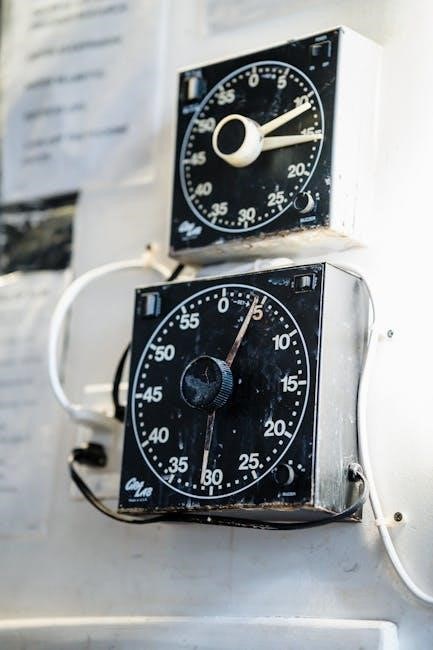Precision radio controlled clocks offer accurate timekeeping using radio signals, with
automatic setting
and reliable performance, making them a popular choice for home and office use always.
Overview of Precision Radio Controlled Clocks
Precision radio controlled clocks are designed to provide accurate timekeeping, using radio signals to set the time automatically. These clocks are equipped with advanced technology that allows them to receive signals from atomic clocks, ensuring that the time displayed is always precise. The use of radio controlled clocks has become increasingly popular in recent years, due to their reliability and convenience. They are widely used in homes, offices, and other settings where accurate timekeeping is essential. With their ability to automatically set the time, precision radio controlled clocks eliminate the need for manual adjustments, making them a practical choice for people with busy lifestyles. Overall, precision radio controlled clocks offer a reliable and efficient way to keep track of time, making them an essential tool in today’s fast-paced world, with many benefits and advantages.

Setting the Clock Automatically
The clock sets itself automatically using radio signals, with precise timekeeping always, every day, with easy instructions and simple steps to follow correctly always.
Receiving the DCF Signal
To receive the DCF signal, the clock must be in a location with a clear signal reception, typically within a certain range of the transmitter. The DCF signal is a long-wave signal that is broadcast from a specific location, and the clock is designed to receive this signal and use it to set the time. The signal is received by the clock’s internal antenna, and the clock then processes the signal to determine the correct time. This process usually takes a few minutes, after which the clock will display the correct time. The DCF signal is a reliable and accurate way to set the time, and it is used by many precision radio controlled clocks. The clock’s ability to receive the DCF signal is an important feature, as it allows the clock to maintain accurate timekeeping.

Environmental Considerations
Clocks require a dry environment with temperatures between 41 F and 131 F for optimal performance always using electronic devices.
Temperature Range and Humidity
The precision radio controlled clock operates within a specific temperature range, between 41 F and 131 F, to ensure accurate timekeeping and reliability.
The clock is designed to function in a dry environment, with minimal humidity, to prevent damage to the internal components and maintain optimal performance.
It is essential to note that the clock is not water-resistant, and users should avoid exposing it to excessive moisture or extreme temperatures.
By following these guidelines, users can ensure their precision radio controlled clock continues to provide accurate and reliable timekeeping, with minimal maintenance and upkeep required.
The temperature range and humidity guidelines are crucial in maintaining the clock’s performance and longevity, and users should take care to adhere to these recommendations.
Proper care and handling will help extend the life of the clock and ensure it continues to provide accurate timekeeping for years to come, with minimal issues or problems.
Atomic Self-Setting Clocks
Atomic clocks provide accurate timekeeping using atomic signals, with automatic setting and reliable performance always ensuring correct time display on the clock face clearly.
Radio-Controlled Precision
Radio-controlled precision is a key feature of precision radio controlled clocks, allowing them to receive signals from atomic clocks and set themselves accurately. This feature ensures that the clock always displays the correct time, without the need for manual adjustment. The radio-controlled signal is received by the clock and used to synchronize its timekeeping, providing a high level of accuracy and reliability; The use of radio-controlled precision in clocks has become increasingly popular in recent years, due to its convenience and accuracy. By using a radio-controlled clock, users can be sure that their clock is always displaying the correct time, which is especially important in applications where accuracy is critical. Overall, radio-controlled precision is an important feature of precision radio controlled clocks, providing a high level of accuracy and reliability. The clock’s precision is also maintained over time.
Features of Precision Radio Controlled Clocks
Precision radio controlled clocks have various features including alarms and snooze functions always available online now.
Alarm and Snooze Functions
The precision radio controlled clock features an alarm and snooze function, allowing users to set reminders and wake-up times with ease, using the provided instructions and online guides.
The alarm sound can be adjusted to a preferred volume, and the snooze function can be set to a specific duration, giving users flexibility and control over their wake-up routine.
Additionally, some precision radio controlled clocks come with advanced features such as sunrise simulation, which gradually increases the light in the room to mimic a sunrise, helping users wake up feeling refreshed and energized.
The alarm and snooze functions can be easily set and adjusted using the clock’s interface, making it a convenient and user-friendly feature.
Overall, the alarm and snooze functions of the precision radio controlled clock make it an essential tool for daily life, helping users stay on schedule and wake up feeling refreshed.

Setting the Clock Manually
Manually setting the clock requires inserting a fully charged battery or connecting to a power source and following specific instructions carefully always using the correct buttons.
Inserting a Fully Charged Battery
To manually set the clock, it is essential to insert a fully charged battery into the device, ensuring the battery is properly aligned with the terminals.
The battery compartment is usually located at the back of the clock, and the battery type is specified in the instruction manual.
It is crucial to use the correct type of battery to avoid any damage to the clock.
The clock will not function correctly if the battery is not fully charged or if it is not inserted correctly.
Always handle the battery with care, avoiding any short circuits or damage to the terminals.
By following these simple steps, you can ensure that your precision radio controlled clock is functioning correctly and providing accurate timekeeping.
The clock is now ready for manual setting, and you can proceed to set the time, date, and other functions according to your requirements.

Troubleshooting Common Issues
Common issues include signal loss and incorrect time display, resolved by checking signal strength and clock settings carefully always using online resources.
Resetting the Clock
To reset the precision radio controlled clock, first remove the battery and wait for a few seconds before reinserting it, this will restart the clock’s system. Then, the clock will automatically search for the radio signal and set the correct time. It is essential to ensure the clock is in a location where it can receive the signal clearly. If the clock is not receiving the signal, try moving it to a different location or checking for any obstacles that may be blocking the signal. The clock’s manual may also provide additional troubleshooting steps and instructions for resetting the clock. By following these steps, the clock should be reset and displaying the correct time. The process is relatively simple and can be done quickly, allowing the clock to continue providing accurate timekeeping.